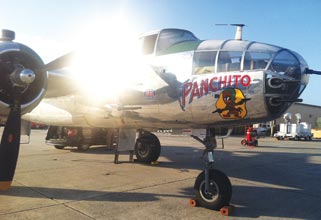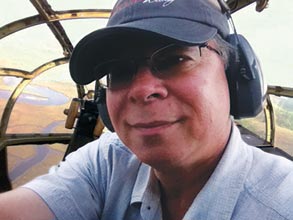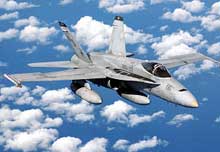
Story and photos by Jeff Evans, publisher
It was getting hot. And it was cramped. But more than anything else it was loud. Really loud. Teeth-rattling, bone-jarring loud. And squeezed into one of the little metal jump seats below the top turret of a vintage B-25 Mitchell Bomber, I was right between the twin engines hanging just outside under each wing. The noise made it impossible to communicate with the photographer crammed into the seat right next to me. I was thankful for the ear protection I was given. And I was thrilled.
I had the great good fortune to take in ride in Panchito, the B-25 flown by the Disabled American Veterans Flight Team. Panchito was in town for the 2015 MCAS Air Show along with other vintage aircraft like the Skytypers’ 75-year old SNJ Trainers and a beautiful P-51 Lightning named Bum Steer. The Navy’s Blue Angels were certainly the belles of the ball, but the vintage planes seemed to evoke a special kind of reverence. You could see it on the faces of people as they walked up close to them. They gazed at these planes and their eyes got a far-away look. These were the planes that really saw action. These were the planes that won the war. These were the planes flown by The Greatest Generation.

Fifteen feet in front of me sat the pilot Larry Kelley, his co-pilot, and Eric Diggs in the jump seat right behind both of them. Eric, a local Marine Corps veteran, was the DAV’s Strength & Courage, Then & Now honoree. He has been working with the DAV in Beaufort for years, helping disabled vets get the benefits they need, and are their due. He was as thrilled as I was. Joining them in the cockpit was the requisite “Little Dancing Hula Girl” stuck to the top of the instrument panel. And she began shaking her hips as we started rolling down the runway – which didn’t take long.
Unlike the commercial flights I’m used to, the takeoff was almost immediate. No  long roll down the runway to work up the speed required for some Boeing or Airbus to get off the ground. I heard the two Wright R-2600 Twin Cyclone engines crank up their 14 cylinders – about 10 feet away – and we’re in the air. It was easy to see why the B-25s were the planes used by Lt. Col. James Doolittle in his famous raid on Tokyo 73 years ago this month. He flew 16 B-25s off the aircraft carrier USS Hornet to prove to the Japanese that we could bring the war to their homeland. And although the damage was minimal, the American public got a much-needed boost in morale following the disaster of Pearl Harbor.
long roll down the runway to work up the speed required for some Boeing or Airbus to get off the ground. I heard the two Wright R-2600 Twin Cyclone engines crank up their 14 cylinders – about 10 feet away – and we’re in the air. It was easy to see why the B-25s were the planes used by Lt. Col. James Doolittle in his famous raid on Tokyo 73 years ago this month. He flew 16 B-25s off the aircraft carrier USS Hornet to prove to the Japanese that we could bring the war to their homeland. And although the damage was minimal, the American public got a much-needed boost in morale following the disaster of Pearl Harbor.
As we flew out over the rivers and marshes of the Lowcountry, we were given the chance to slide head-first through a little tunnel under the flight deck to the glass enclosed nose of the plane. Here was where the forward machine gun was, along with the little bomb site – which honestly looked no more sophisticated than a protractor with a small stick stuck to it.
On the ground we had seen the bombs hanging inside the small bomb bay. These were apparently created from the original molds for 500 lb. bombs and covered with signatures from original flight crew members who had flown in the B-25 during the war.
Making my way back through the tunnel I got to stand on our seats and look out the top turret while the photographer took his turn in the nose. The space for the little fold out seats would normally be taken up with the electrical equipment, ammunition and gunners seat used to operate the top turret. When I poked my head up inside the turret the 360˚ view was tremendous and I could see over all of Beaufort and its marshes and creeks.
I had asked Larry Kelley if he knew any of the history of Panchito and was told the original plane had been delivered to Okinawa in 1944. I thought about what it must have been like to be stuck inside this cramped, noisy airplane for hours on end in tropical heat. How much weight would you lose? Would you regain your hearing? Then I began to think of my father.
He was drafted into the army in June of 1941 – six months before Pearl Harbor –  and served three years in the Pacific. He had made it to Okinawa by 1944 and even though he was in the infantry, he me he’d hopped a ride in a B-25 a couple of times to get from one place to another. Apparently they did that back then. He had remembered this because it had been the same plane used by Doolittle’s Raiders during his bombing of Tokyo.
and served three years in the Pacific. He had made it to Okinawa by 1944 and even though he was in the infantry, he me he’d hopped a ride in a B-25 a couple of times to get from one place to another. Apparently they did that back then. He had remembered this because it had been the same plane used by Doolittle’s Raiders during his bombing of Tokyo.
My father’s war ended on Okinawa after he was wounded for the second time, the first being in the Philippines. He’d been shot through the right elbow by a machine gun, which “spun me around like a top,” he said, and then spent almost a year in the hospital. They saved his arm but he could never fully straighten it again.
I thought of Dad as we came in for a landing back at MCAS and realized this was exactly the same kind plane he’d ridden in. And then I thought that maybe he’d been in this exact same airplane. And I decided that this is what I would choose to believe. That this airplane and my father were both a part of The Greatest Generation.
My father continued to serve in the army after the war and finally retired as an infantry colonel, having seen combat in three wars. Panchito was another old veteran who still serves those who have given a part of themselves for their country.
The Disabled American Veterans is a non-profit organization dedicated to military veterans who suffered some degree of disability while serving in time of war or armed conflict. The DAV helps veterans and their families get all the benefits they deserve and never charges for these services. The DAV also lobbies Congress on behalf of veterans for disability compensation, pension, medical care, job and training programs, burial benefits, education and survivors’ benefits. For more information about DAV in Beaufort visit http://beaufortdav12.org







